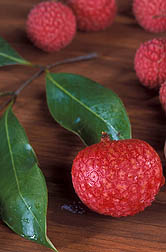This page has been archived and is being provided for reference purposes only. The page is no longer being updated, and therefore, links on the page may be invalid.
Read the magazine story to find out more. |
|
|
Lychee Studies Yield Keys to Plentiful, Predictable Harvests
By Marcia WoodMay 18, 2009
Lychee, an exotic tropical fruit, is perhaps best known for the flavorful ice cream you can often find at Asian restaurants. But this luscious fruit can also be eaten fresh, or made into elegant sauces, distinctive jams or jellies, and more.
Though lychee can be grown in Hawaii, the mild, sunny climate of the Island State doesn't precisely match that of lychee's southern China origins. To boost farmers' chances of plentiful, predictable harvests of large, delicious lychee in Hawaii, Agricultural Research Service (ARS) research horticulturists Tracie Matsumoto and Francis T.P. Zee have developed and tested a regimen of pruning and fertilizing lychee trees. They're working with a variety known as Kaimana.
Now, the scientists and their University of Hawaii colleagues are fine-tuning their management system for Kaimana trees. Zee and Matsumoto are with the ARS Tropical Plant Genetic Resources and Disease Research Unit, part of the U.S. Pacific Basin Agricultural Research Center in Hilo, Hawaii.
Some growers who've tried the scientists' lychee management protocol in Hawaii have reported impressive results. For example, they've noted yields averaging more than 100 pounds of delectable, nicely sized fruit per tree.
Many Kaimana trees that are now top performers previously produced less than half that much fruit or, in some years, no fruit at all, according to the researchers.
None of the procedures—precisely timed fertilizing and pruning—are, in themselves, new to orchardists. Instead, it's the combination, timing and specific details of each technique that make the management system different from what many Kaimana growers have tried in the past.
The management system is based on six years of observation and experimentation with Kaimana trees growing on the rainy side of Hawaii Island. Now Matsumoto is determining how to make the tactics as successful in the island's other microclimates.
Read more about this research in the May/June 2009 issue of Agricultural Research magazine.
ARS is the principal intramural scientific research agency of the U.S. Department of Agriculture.

